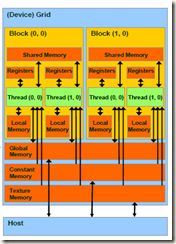CUDA的学习
CUDA的学习
前面几天写了三维重建中的特征提取部分,下面接着写,不过今天写一下CUDA的内容,这个下面要用到,要学习,首先装环境,装了CUDA5.0,网上有一个windows7+CUDA5.0的教程,挺好,按照那个基本上没有问题,不过实际在运行的过程中发现了一个问题,就是不同通过windows的远程桌面连接,远程桌面不能调用显卡。
于是想远程操作的则可以下载一个Symantec pcAnywhere,远程控制软件。好了不多说,我们就先看第一个程序。也就是CUDA5.0自带的demo。
把整个程序列上来,然后加了点注释,这个也只是参考加上本人的理解,也不知道正确与否。望大家指正。
#include "cuda_runtime.h" //使用 runtime API
#include "device_launch_parameters.h"
#include <stdio.h>
cudaError_t addWithCuda(int *c, const int *a, const int *b, size_t size);
// 显示芯片上执行的程序。在 CUDA 中,在函式前面加上
// __global__ 表示这个函式是要在显示芯片上执行的。
// 在显示芯片上执行的程序有一些限制,例如它不能有传回值。
// 接下来是要让 CUDA 执行这个函式。
__global__ void addKernel(int *c, const int *a, const int *b)
{
// threadIdx 是 CUDA 的一个内部的变量,表示目前的 thread 是
//第几个 thread(由 0 开始计算)这边会有 size =5 个 threads
//每一个的 threadIdx.x 则分别会是 0 ~ 5。利用这个变量,我们
//就可以让每一份函式执行时,对整个数据不同的部分进行相加。
int i = threadIdx.x;
c[i] = a[i] + b[i];
}
int main()
{
const int arraySize = 5;
const int a[arraySize] = { 1, 2, 3, 4, 5 };
const int b[arraySize] = { 10, 20, 30, 40, 50 };
int c[arraySize] = { 0 };
// Add vectors in parallel.
cudaError_t cudaStatus = addWithCuda(c, a, b, arraySize);
if (cudaStatus != cudaSuccess) {
fprintf(stderr, "addWithCuda failed!");
return 1;
}
printf("{1,2,3,4,5} + {10,20,30,40,50} = {%d,%d,%d,%d,%d}\n",
c[0], c[1], c[2], c[3], c[4]);
// cudaDeviceReset must be called before exiting in order for profiling and
// tracing tools such as Nsight and Visual Profiler to show complete traces.
cudaStatus = cudaDeviceReset();
if (cudaStatus != cudaSuccess) {
fprintf(stderr, "cudaDeviceReset failed!");
return 1;
}
return 0;
}
// Helper function for using CUDA to add vectors in parallel.
cudaError_t addWithCuda(int *c, const int *a, const int *b, size_t size)
{
int *dev_a = 0;
int *dev_b = 0;
int *dev_c = 0;
cudaError_t cudaStatus;
// Choose which GPU to run on, change this on a multi-GPU system.
// 选择哪个GPU去运行,这个在多GPU系统上修改。
cudaStatus = cudaSetDevice(0);
if (cudaStatus != cudaSuccess) {
fprintf(stderr, "cudaSetDevice failed! Do you have a CUDA-capable GPU installed?");
goto Error;
}
// Allocate GPU buffers for three vectors (two input, one output)
// 给三个向量(两个输入,一个输出)分配GPU缓存.
// 要利用 CUDA 进行计算之前,要先把数据复制到显卡内存中,// 才能让显示芯片使用。因此,
// 需要取得一块适当大小的显卡内存,再把产生好的数据复制进去
cudaStatus = cudaMalloc((void**)&dev_c, size * sizeof(int));
if (cudaStatus != cudaSuccess) {
fprintf(stderr, "cudaMalloc failed!");
goto Error;
}
cudaStatus = cudaMalloc((void**)&dev_a, size * sizeof(int));
if (cudaStatus != cudaSuccess) {
fprintf(stderr, "cudaMalloc failed!");
goto Error;
}
cudaStatus = cudaMalloc((void**)&dev_b, size * sizeof(int));
if (cudaStatus != cudaSuccess) {
fprintf(stderr, "cudaMalloc failed!");
goto Error;
}
// Copy input vectors from host memory to GPU buffers.
// 复制输入向量从主存到显卡内存。
// 通过调用cudaMalloc 取得一块显卡内存,然后通过过
// cudaMemcpy 将上述两个数组复制到显卡内存中.
// cudaMalloc 和 cudaMemcpy 的用法和一般的 malloc 及
// memcpy 类似,不过 cudaMemcpy 则多出一个参数,指示复制内// 存的方向。在这里因为是从主内存复制到显卡内存,所以使用
// cudaMemcpyHostToDevice。如果是从显卡内存到主内存,则使用 // cudaMemcpyDeviceToHost。
cudaStatus = cudaMemcpy(dev_a, a, size * sizeof(int), cudaMemcpyHostToDevice);
if (cudaStatus != cudaSuccess) {
fprintf(stderr, "cudaMemcpy failed!");
goto Error;
}
cudaStatus = cudaMemcpy(dev_b, b, size * sizeof(int), cudaMemcpyHostToDevice);
if (cudaStatus != cudaSuccess) {
fprintf(stderr, "cudaMemcpy failed!");
goto Error;
}
// Launch a kernel on the GPU with one thread for each element.
// 函式名称<<<block 数目, thread 数目, shared memory 大小
// >>>(参数...);
//在 CUDA 中,thread 是可以分组的,也就是 block。一个 block 中//的 thread,具有一个共享的 shared memory,也可以进行同步工作。//不同 block 之间的 thread 则不行。在我们的程序中,其实不太需//要进行 thread 的同步动作,因此我们可以使用多个 block 来进一//步增加 thread 的数目。就是把这个1改变
addKernel<<<1, size>>>(dev_c, dev_a, dev_b);
// cudaDeviceSynchronize waits for the kernel to finish, and returns
// any errors encountered during the launch.
cudaStatus = cudaDeviceSynchronize();
if (cudaStatus != cudaSuccess) {
fprintf(stderr, "cudaDeviceSynchronize returned error code %d after launching addKernel!\n", cudaStatus);
goto Error;
}
// Copy output vector from GPU buffer to host memory.
cudaStatus = cudaMemcpy(c, dev_c, size * sizeof(int), cudaMemcpyDeviceToHost);
if (cudaStatus != cudaSuccess) {
fprintf(stderr, "cudaMemcpy failed!");
goto Error;
}
Error:
cudaFree(dev_c);
cudaFree(dev_a);
cudaFree(dev_b);
return cudaStatus;
}
使用5.0的时候要注意跟以前版本的不一样的地方,一个是这个版本里面没有了
#include "cuda_util.h"
也就是以前使用的向CUDA_SAFE_CALL之类的就不好使用了
修改以前版本的可以去掉通过上面的方法使用cudaError_t,也可以使用
#include <helper_functions.h>
#include <helper_cuda.h>
不过不是C:\Program Files\NVIDIA GPU Computing Toolkit\CUDA\v5.0\include
下的头文件最好不要引用,以免跟上面一样。
在对于CUDA 的操作中,开始的时候要将主存上的数据复制到GPU上,而GPU上又分为好几种
几种的区别以及何时用,也就是一个优化的过程,这个是个难点。
下面就主要的是一个并行算法的问题,这个也是最关键的。
下面再把Blocks 和 Threads和grid的关系图放上来
这样一个基本的CUDA程序就基本上了解了,不过要理解的还有很多,先写这么多。
http://www.cnblogs.com/fengbing/category/417672.html
![clipboard[1] CUDA的学习_第2张图片](http://img.e-com-net.com/image/info5/4462b3b81e5444309271fcfc6cb43f9b.jpg)